The Bombay cat is one of the most distinctive cat breeds out there with its jet-black coat and captivating copper eyes. If you’ve ever seen one, you probably did a double take – they really do resemble mini panthers! While their exotic looks are what draw people in initially, Bombays have so much more to offer than just good looks. They are playful, affectionate and loyal companions that form strong bonds with their families.
However, Bombays are not for everyone. Like any pedigreed cat, they have some special considerations that potential owners should understand before bringing one home. For instance, Bombays tend to be “Velcro cats” that need a lot of attention. They thrive on being involved in family activities and don’t do well left alone for long periods. Bombays also have fairly high activity levels and require adequate playtime and stimulation.
Whether you’re considering adding a Bombay to your family or are just curious to learn more about this eye-catching breed, read on to discover everything you need to know. This guide will cover their origins, physical features, personality traits, care requirements and health concerns. With this information, you’ll be well equipped to decide if a Bombay would be a good fit for your lifestyle.
Bombay Cat Origins & Development
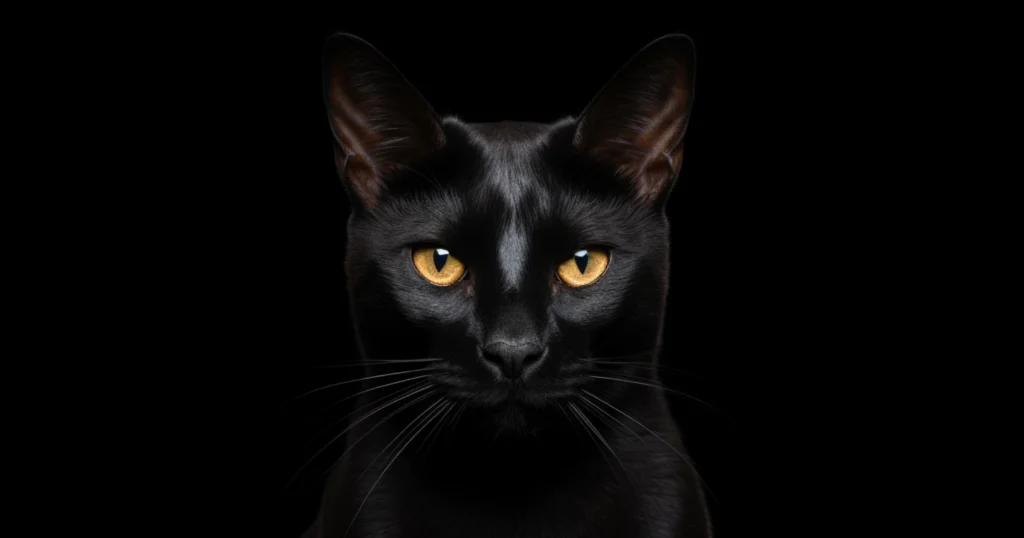
The Bombay cat breed was first developed in 1958 by Nikki Horner, an American breeder living in Louisville, Kentucky. Horner had a dream of creating a breed of cat that resembled a miniature black panther. She was inspired by images of the black leopards of India and wanted to replicate their sleek, jet black coat in domestic cats.
To achieve this goal, Horner bred an American Shorthair female with a solid black coat to a sable Burmese male. The kittens from this pairing had black coats, but still carried the tabby gene that gave their coats a brownish cast and produced ghost tabby markings.
Horner continued breeding the kittens back to black American Shorthairs for 3 more generations until the kittens consistently had pure black coats without tabby markings. The resulting cats combined the Burmese body and head type with the dense, gleaming black coat of the American Shorthair.
In 1965, after 7 generations of selective breeding, the dark brown Burmese traits had been eliminated and the Bombay breed was officially established. The name “Bombay” was chosen for the breed in reference to the Indian city of Bombay, as their shiny black coats evoked images of the black leopards that lived there.
Horner worked to promote the Bombay breed by exhibiting them at cat shows across the United States. Over the next decade, other breeders became interested and began establishing their own Bombay breeding programs using Horner’s cats.
The Cat Fanciers Association first granted championship status to the Bombay breed in 1970. Ten years later in 1980, the breed gained full recognition from the CFA and could now compete at shows for premiership titles.
Today, the Bombay remains a relatively rare breed. But those who own Bombays are smitten with their playful personalities and lustrous black coats. Enthusiasts appreciate the breed for embodying the exotic look of a wild panther, while retaining the affectionate nature of the domestic cat.
Physical Appearance of the Bombay Cat
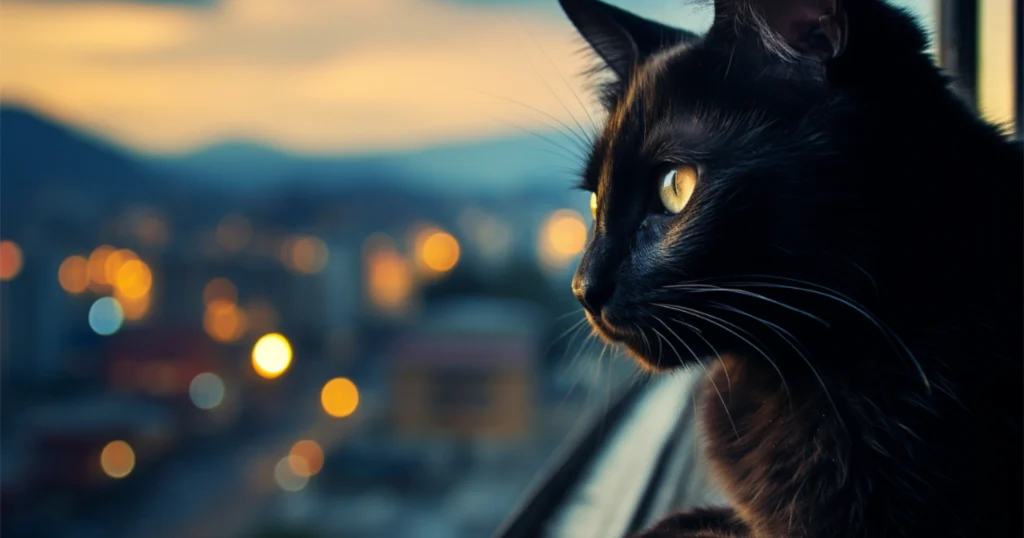
Bombay’s all-black coat.
The most distinguishing feature of the Bombay cat is its gleaming, jet-black coat. Bombays have a short, satin-like double coat that lies close to the body and reflects light for a patent leather appearance. When examined closely under bright lighting, the individual hair strands are brown or burnt sienna at the roots. But the coat color is so dense that it appears completely black overall – even the paw pads and nose leather are black.
The only points of color on a Bombay are their vibrant copper or gold eyes. The jet black paw pads, nose, and mouth contrast strikingly against their shimmery black fur.
Eye color variations: copper or gold.
Bombays are known for their large, owl-like eyes that shine in fiery copper and gold hues. Their eye color stands out dramatically against their lush black coat.
Body build: medium and muscular.
Bombays have a muscular yet graceful build. They are medium-sized cats with a moderate, rounded torso that is broad-chested. Their shoulders are muscular and they have substantial hindquarters with powerful hips and thighs. Bombays were bred to emulate the Burmese body type.
Weight range: 8 to 15 pounds, with males typically being heavier than females.
Adult typically weigh between 8 to 15 pounds when fully grown, with males generally larger than females. Proper feeding is important as Bombays can easily become overweight. Their sleek panther-like physique requires controlled portions and regular activity to maintain.
Personality and Behavioral Traits
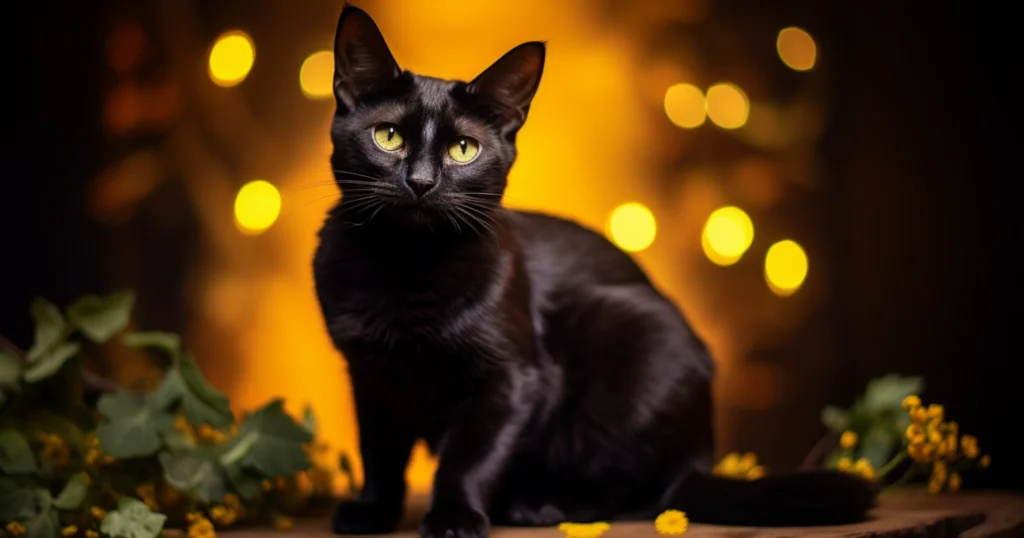
Characteristics that make them friendly and sociable.
Bombays are known for being extremely social, playful, and attached to their families. They form deep bonds with their owners and crave companionship and affection. Bombays tend to choose one special person in the household to serve as their primary attachment figure.
Their love for spending time with their owners.
These cats love being involved in family activities and enjoy playing fetch, learning tricks, and anything else that engages their high intellect. Bombays want to be wherever you are and don’t do well left alone for long periods. They can become anxious or depressed if their social needs aren’t met.
Interaction with other people and pets.
This breed tends to be highly adaptable and gets along well with children and other pets when properly socialized from kittenhood. Bombays crave human interaction, though they can be initially shy around strangers. Once comfortable, guests will be greeted warmly.
Activity level: love for games and playfulness.
Bombays tend to be lively cats that stay playful well into adulthood. They enjoy climbing cat trees, chasing toys, and playing games of fetch or tag. Bombays need consistent daily exercise paired with loving attention to be content.
Emotional needs: Prone to depression if left alone for extended periods.
While Bombays are highly attached to their families, they are not clingy when their needs for activity and affection are fulfilled. Solo time will be spent self-entertaining with toys or catnaps.
Suitability: Not ideal for those who work long hours or travel frequently.
The Bombay’s extreme need for companionship means this breed isn’t the best choice for those who travel often or work long hours away from home. For the right family who can devote ample time to interact with a Bombay daily, this breed makes a delightful companion.
Grooming Requirements
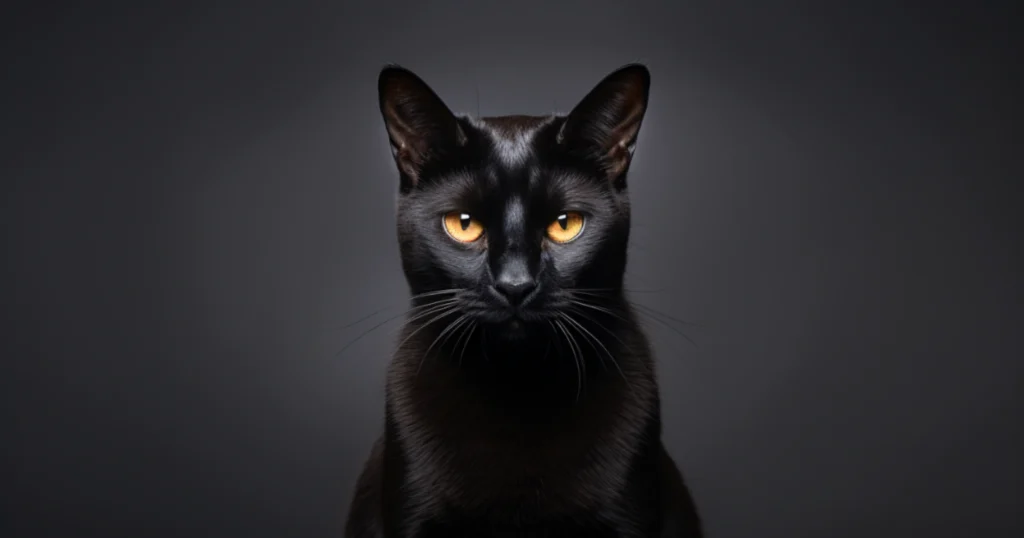
The Bombay has a short, satiny coat that lies close to the body. The individual hairs are fine in texture and give the coat a smooth, glossy finish. Bombays have relatively low grooming requirements compared to long-haired breeds.
Coloring nuances: Coat colored to the roots with little or no paling.
A high-quality Bombay coat will be colored black all the way down to the roots. There should be minimal paling or rusting. The more intense coal black color is preferred over brownish-black.
Frequency and method of grooming: once a week recommendation.
While Bombays are low-maintenance in terms of grooming, their coat still benefits from weekly brushing. This helps remove loose hair and distribute skin oils for maximum shine. A chamois cloth can be used to buff the coat and enhance its patent leather sheen. Baths are only needed on an occasional basis when the cat becomes soiled.
Housing and Living Space

Benefits of being strictly indoor cats.
Bombay cats are highly adaptable and content living solely indoors provided their environment is appropriately enriched. Keeping Bombays indoors protects them from diseases, accidents, and other hazards while allowing their human companions to better monitor their health and happiness. Indoor Bombays can enjoy long, safe lives when their needs for exercise and stimulation are fulfilled inside the home.
Climbing and jumping tendencies: Importance of cat trees and perches.
Bombays are agile, active cats that love to climb and jump. Providing tall cat trees, wall-mounted shelves, window perches, and other vertical surfaces encourages them to exercise their natural athleticism. Be sure to place cat furniture strategically to allow your Bombay to gaze safely out windows for mental stimulation.
Space requirements: Combination of indoor and outdoor space.
While Bombays don’t require access to the outdoors, they do need ample room to run, climb and play indoors. It’s ideal to provide both horizonal floor space for games and racing around, along with vertical climbing structures. Screened-in “catio” enclosures also allow safe outdoor access. Bombay cats can thrive in apartments with sufficient play areas, but a home is preferable.
Health and Lifespan
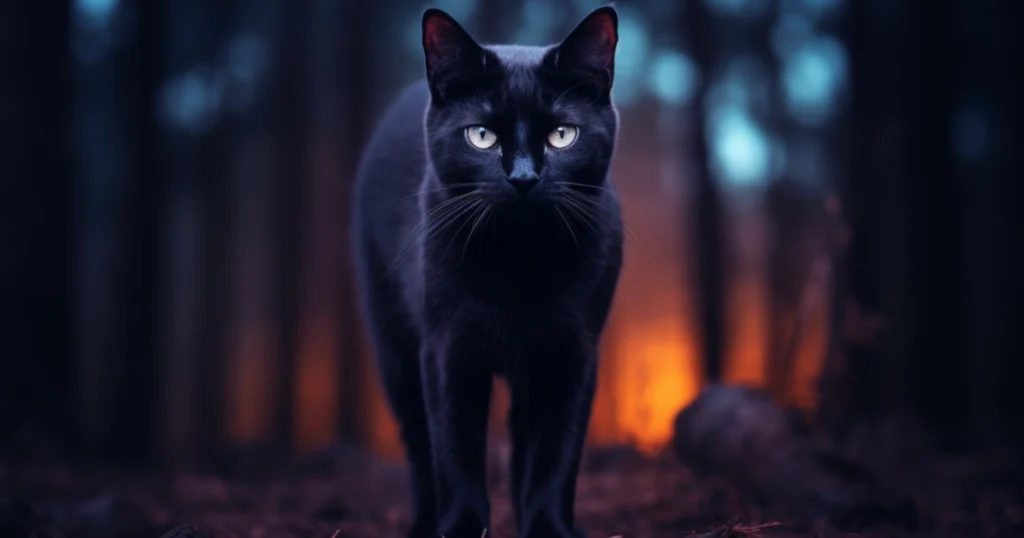
Bombay cats are known for their robust health and long lifespan. With the right care, these little panthers can grace your home for up to 20 years. Yes, you heard that right—two whole decades of purrs and cuddles!
Common health issues and preventive measures.
While Bombays are generally a healthy breed, they can be predisposed to certain health conditions, just like any other breed. This includes hypertrophic cardiomyopathy (a form of heart disease) and craniofacial defects, which are issues Bombay breeders strive to screen out.
There’s also a possibility of obesity due to their love for food and tendency towards a laid-back lifestyle. To prevent this, ensure they get enough playtime and feed them a balanced diet in controlled portions.
Importance of regular veterinary check-ups.
Bombay cats benefit from annual wellness exams and bloodwork after age 7 to screen for illnesses. Twice-yearly veterinary visits are preferable for senior cats over age 10. Keeping up with routine care provides the best opportunity to catch issues early on when they are most treatable.
Even with the possible health concerns, don’t let that scare you away from the breed. Bombay cats make wonderful companions, and their potential health issues are manageable with proper care and attention. Remember, a well-cared-for Bombay cat can be your loyal friend for up to 20 years—making every vet visit, play session, and balanced meal worth it.
Tips for Potential Bombay Cat Owners
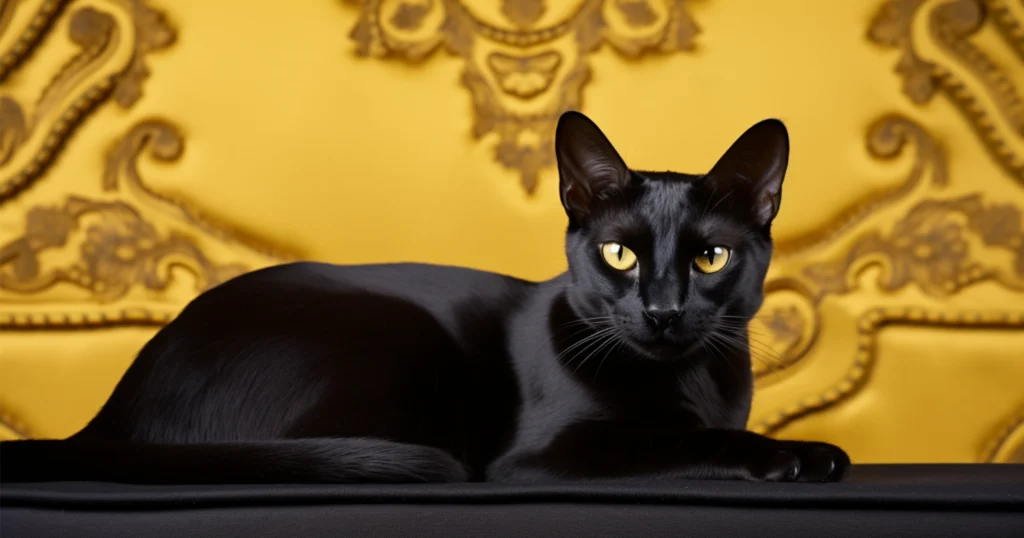
Thinking of bringing a Bombay cat into your life? Good choice! This sociable and affectionate breed can be an excellent pick, especially for first-time cat owners. But, as with any pet, there are a few things to consider before making the leap.
Firstly, understand that Bombay cats are all about companionship. They thrive on human interaction and don’t do well with loneliness. If you’re out most of the day, or travel frequently, a Bombay might not be the best choice. But, if you’re working from home or have a family that can give them plenty of attention, they’ll be right at home.
Physically, Bombay cats have a fairly low maintenance coat, but they do need regular playtime to stay fit and stave off obesity. Ensure that you can provide this, alongside a balanced diet, to keep them in good health.
Emotionally, Bombays are known for their “dog-like” nature. They’re likely to follow you around, join in on your activities, and might even fetch a toy or two! This means they need mental stimulation just as much as physical play. Make sure to provide a variety of interactive toys, puzzles, and regular play sessions.
Another tip for a happy Bombay is to provide a stimulating indoor environment. Vertical spaces like cat trees or shelves, and a variety of hiding and lounging spots will keep them entertained. And remember, Bombays should be kept indoors for their safety.
Lastly, never underestimate the power of a regular vet check-up. It’s the best way to catch potential health issues early and to ensure your Bombay cat is at their best.
Conclusion
These sleek, all-black felines, known as “parlor panthers”, have certainly carved out a special niche in the cat world. From their origins as a crossbreed between sable Burmese and black American Shorthair cats, to their muscular physique, they’re truly unique.
Their glossy black coat, dark soles, nose, and mouth, coupled with striking copper or gold eyes, make them stand out in any cat crowd. Beyond looks, they’re characterized by their social and friendly nature, creating bonds that are much like those between dogs and their humans.
However, Bombay cats have special needs too. Their desire for company and mental stimulation means they need an environment that caters to their emotional needs. With a propensity for depression if left alone too long, they’re not the best fit for everyone. They’re ideal for homes where they will have plenty of interaction, and not so ideal for those with long working hours or frequent travel.
For individuals or families who can provide the activity level, socialization, and consistent care Bombay cats require, they will be rewarded with years of unwavering devotion from these darling black beauties. Bombay cats offer exotic good looks paired with extreme friendliness when their needs are met. Do your homework to ensure this breed is a good match before bringing one home. If you can make the commitment, a Bombay cat will return your dedication with feline love and loyalty beyond measure.


